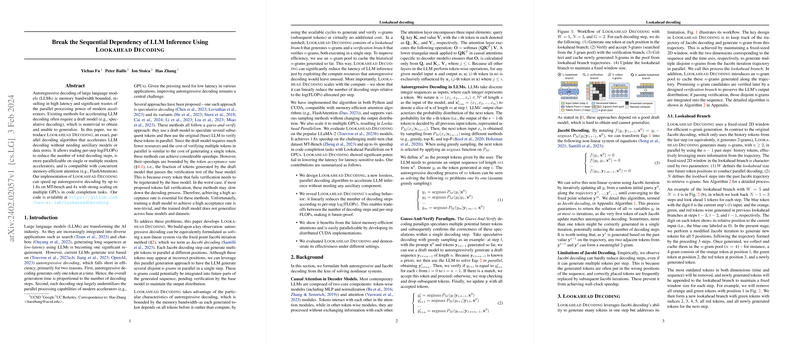Lookahead Decoding: Enhancing LLM Inference
The paper "Break the Sequential Dependency of LLM Inference Using Lookahead Decoding" addresses a fundamental challenge in the deployment of LLMs: the inefficiency of autoregressive decoding. Autoregressive decoding, a prevalent method for generating sequences in LLMs, has traditionally relied on generating one token at a time. This process not only results in high latency but also underutilizes the parallel processing capabilities of modern accelerators, such as GPUs, due to its memory bandwidth-bound nature.
Key Contributions
The paper introduces Lookahead Decoding, a novel algorithm that accelerates LLM decoding by fundamentally rethinking how sequences are generated. Unlike traditional methods that rely on auxiliary models like speculative decoding, Lookahead Decoding operates without any additional models, focusing instead on leveraging the parallelizable aspects of sequence generation.
- Parallel Decoding through -grams: Lookahead Decoding formulates the decoding process as solving a non-linear system using the fixed point Jacobi iteration method. This approach allows for the generation of multiple tokens in parallel, potentially integrating several disjoint -grams into the final sequence output within a single step.
- Efficiency and Compatibility: The algorithm efficiently reduces the number of decoding steps by trading per-step computational effort with the overall generation length, showing up to 1.8x speedup in chat datasets and 4x in code completion tasks with strong scaling across multiple GPUs. It also remains compatible with memory-efficient attention mechanisms, such as FlashAttention.
- Scalability: Lookahead Decoding is demonstrated to exhibit strong scalability, linearly reducing decoding steps as a function of per-step FLOPs. This scalability is particularly beneficial for latency-sensitive tasks deployed across multiple GPUs.
Numerical Results
The paper presents compelling numerical results. On the MT-Bench multi-turn chat dataset, Lookahead Decoding achieved a speedup of 1.8x, while code completion tasks saw up to a 4x performance increase with Lookahead Parallelism on 8 GPUs.
Implications and Future Directions
The introduction of Lookahead Decoding offers substantial implications for both theoretical understanding and practical application of LLMs. By eschewing additional models and focusing on inherent parallelization opportunities, the approach significantly reduces latency while maintaining output distribution. It paves the way for further exploration into non-sequential decoding strategies that could harness modern hardware architectures more effectively.
Practically, this methodology can be immediately impactful in fields requiring rapid LLM deployment, such as real-time translation or interactive AI applications. Theoretically, it challenges existing paradigms of LLM inference and encourages future research to explore alternative parallel decoding mechanisms that could further diminish reliance on sequential processes.
Future work might investigate extending Lookahead Decoding to other architectures or application domains beyond NLP, potentially enhancing a wide array of sequence generation tasks. Moreover, the integration of Lookahead Decoding with newly emerging hardware accelerators could uncover additional layers of parallelism and efficiency.
In conclusion, Lookahead Decoding represents a significant advancement in the optimization of LLM inference, offering a promising direction for achieving lower latency inference while maximizing computational resources.
